canolaPALOOZA 2018 was at AAFC Saskatoon June 25 and AAFC Lacombe June 27. Here are the top 10 questions from the two events.


Listen to CCC agronomy specialists talk canolaPALOOZA on RealAg Radio
1. How many plants should I target for my canola stands? This was a common question at the stand establishment station, and the specialists at that station mostly agreed that they would want at least 6 plants per square foot at the beginning of the season (InVigor advises their growers to target 5-7 plants per square foot.) Depending on a grower’s appetite for risk, they could target lower populations but should be prepared to manage thinner stands more intensively. If you aren’t sure how many plants per square foot you have in your fields, go out and count with a hula hoop, metre stick or tape measure. Then input your findings along with TSW and seeding rate on www.canolacalculator.ca to calculate your plant survival (seed emergence percentage). Leading-edge growers set plant density targets and assess their performance every season to decide where improvements in their operations can be made.
2. What do beneficial insects actually do? Canola in Western Canada has 12 or so major pest insects. Canola fields also provide habitat for hundreds of other insect species, many of which parasitize the pest insects. Two beneficial insects found in the plots at canolaPALOOZA are rove and ground beetles.
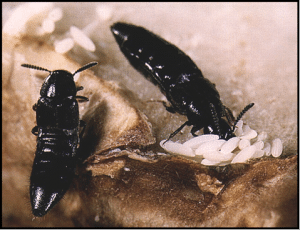
Rove beetle. Aleochara bilineata, of the Staphylinidae family of rove beetles, are one of the largest predators of a very common pest of canola: the cabbage root maggot. Each adult can consume 23 root maggot eggs or about 2.5 fresh maggots per day, and in their lifetime a pair of A. bilineata beetles can consume 1,200 eggs and 128 larvae! While few studies have been performed, it has been commonly observed in Canada and Northern Europe that fields sprayed early with a foliar insecticide (for flea beetle or cabbage stem flea beetle) tend to have greater damage from root maggots. One potential reason for this is the killing of these staphylinid beetles with the insecticide leads to less predation of eggs and larvae of root maggots. Foliar applications of insecticide should only be made when economic thresholds for pests have been exceeded. This will conserve populations of natural enemies, while ensuring chemical applications are made in an economically beneficial manner.
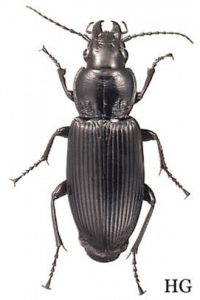
Ground beetle. Among the most biodiverse group of insects on the Prairies, carabid beetles (ground beetles) can be found on every acre of every field in Canada. Nearly 400 species of ground beetles have been identified in Canada, and individual fields can often boast being home to as many as 50 different species. Carabids are predominantly nocturnal, and surprisingly difficult to catch during the day. None of the carabid beetles are pests: they are all generalist predators of many of our pest species. The larger species have a particular affinity for consuming cutworms, and several species have been observed climbing canola plants in pursuit of diamondback moth. Some of the larger beetles (such as the Pterostichus melanarius, pictured) can consume 5-6 cutworms in a 24 hour period. Other carabid beetle species feed on seeds on the soil surface, consuming a substantial amount of weed seeds. When present at densities commonly found (in excess of 30/m2), this hugely important group of insects is a veritable army of insect and weed management specialists. All natural or uncultivated spaces – fencelines, shelterbelts, wooded bluffs, grassed strips, wetlands, etc – provide refuge for carabid beetles to live, overwinter, and reproduce. For this reason (among others) it is important to observe economic thresholds for insect pests; unnecessary applications of foliar insecticides can be catastrophic to populations of carabid beetles, as well as the thousands of other species of natural enemies and beneficial insects commonly found in agricultural lands. Read more at FieldHeroes.ca.
3. How long from sclerotia germination to spore release? It takes 2-3 weeks of soil moisture for this cycle: sclerotia imbibe moisture, sclerotia germinate to form apothecia, apothecia release spores. Read more.
4. Is verticillium wilt something I need to worry about? Verticillium wilt is a newly discovered disease of canola and is widespread on the Prairies, but we don’t know if it causes yield loss. Research is only starting now. Agronomists and farmers should become aware of how to identify this disease. If they find it or have questions then contact the CCC. Read more.
5. If you leave a check strip, how do you know if data from that check strip will provide any value? Replication within fields is important and taking time to carefully harvest and weigh each strip separately is essential to producing useful information. Replication beyond the farm, in collaboration with other farmers or research organizations, will also help to see how the treatment works under a variety of growing conditions. See protocols for on-farm trials at the Ultimate Canola Challenge website.
6. How would the blackleg race test help with my management of the disease? Clubroot seemed to get more attention at canolaPALOOZA, but with tight rotations and shifting of blackleg pathotype (races) within fields, growers are increasing their blackleg risk. Identifying the races present on blackleg-infected canola plants will help farmers make more strategic variety decisions for the next time canola is grown in that field. The blackleg race test should be used on fields where documented increases in blackleg disease pressure have been seen during pre-harvest disease surveys. Producers should look to match a varieties major gene group(s) to the blackleg phenotype reported on the test.
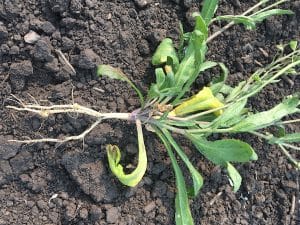
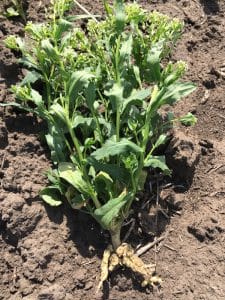
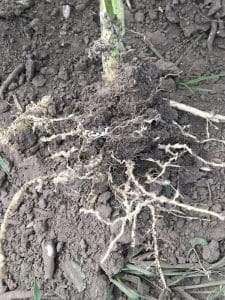
7. What weeds can host clubroot? Clubroot galls have been found on stinkweed, shepherd’s purse and flixweed in Alberta. These are known hosts for clubroot, so this discovery is not a surprise. It serves as a reminder to control these weeds, especially in fields known to have clubroot, and in all crops throughout the rotation. These weeds that escape control in a wheat crop, for example, serve as a strong bridge for clubroot in non-canola years and can greatly reduce the value of crop rotation as a management tool. Within three weeks of emergence, galls can start to form. Killing weeds within three weeks of emergence will stop this, but note that herbicides do not kill instantly. Note that weeds can be susceptible to different clubroot pathotypes, so it can happen that host weeds do not get clubroot when canola does, and vice versa.
8. What is the safe-rate of seed-placed fertilizer? Established guidelines are on the conservative side. In Canola Watch, we often recommend that no more than 20 lb./ac.of phosphate go in the canola seed row – and nothing else. At canolaPALOOZA in Saskatoon this year, there was no visual difference between rates from 0 to 65 lb./ac. of phosphate. At canolaPALOOZA in Alberta this year, plots that had one third of the total fertilizer package (including N, P, K and S) put in the seed row had clear and significant thinning compared to plots next door that had only 20 lb./ac. of seed-placed phosphate. At Manitoba canolaPALOOZA in past years, we observed plant stand reduction from as little as 15 lb./ac. of phosphate. Soil type and environmental conditions play a big role in the safety threshold. Read more.
9. How do I set a combine to minimize harvest losses? This was a key question at the harvest station. Before combine optimization can occur effectively, threshing losses need to be properly evaluated to calibrate the loss monitor. Growers have many effective drop-pan options to check for losses, and any method is better than not checking at all. Threshing losses can be substantial, realistically reaching 5 bu./ac. or more. A reasonable goal is 1-2% of yield, but that may not be achievable in all conditions. Losses should be re-evaluated when setting changes are made. Ideally, settings should be adjusted when there is substantial change in the crop and/or weather condition. Read more.
10. How can technology improve my agronomy decisions? canolaPALOOZA featured demonstrations of WEEDit, which uses sensors to detect green weeds and then trigger a spot spray to that weed. It eliminates the need for blanket sprays. AgraBot autonomous tractors could reduce the labour push to get things done fast so you can move on to the next pressing job. It could allow a farm to take more time with seeding to improve seed placement for example.
If you missed canolaPALOOZA, but still want a physical takeaway, check out the agronomic-focused publications that were featured at the resource station and select which ones you would like sent to you, free of charge! The newest ones are the ‘Understanding Blackleg Resistance’ and ‘Understanding Clubroot Resistance’ brochures and annual Canola Performance Trial results booklet, but the insect and disease scouting guides were also popular hand-outs this year. If you want something more interactive, check out the canolaPALOOZA videos on the Canola Research Hub.
You have one more chance to ‘PALOOZA in 2018. CROPS-A-PALOOZA July 25 in Portage la Prairie, Manitoba. Read more.
Listen to CCC agronomy specialists talk canolaPALOOZA on RealAg Radio

